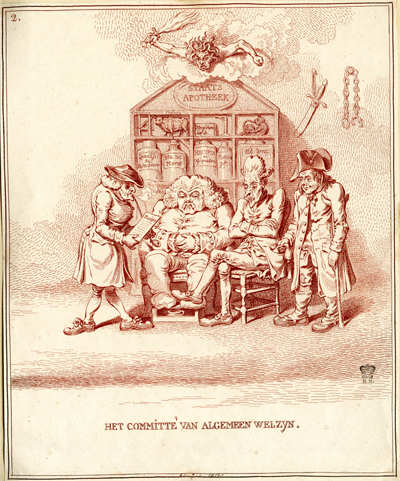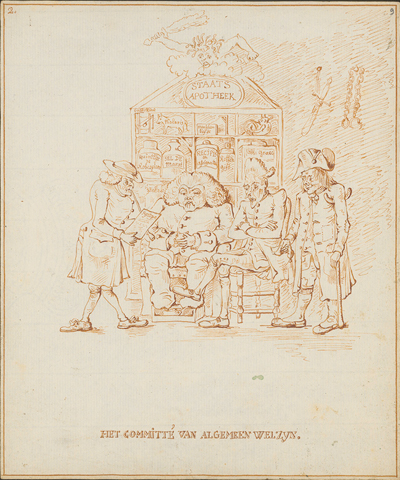Het Committé van Algemeen Welzyn
This is the second plate of a twenty plate series, Hollandia Regenerata, etched by Gillray based on drawings by the Swiss soldier, painter, and caricaturist, David Hess. For more about David Hess, and the political and artistic context of the series satirizing the newly-created and French-supported Batavian Republic, see my Introduction.
The title can be translated as "The Committee of General Well-being." But the print shows a group of committee members, far from well themselves, sitting in a kind of solipsistic torpor before a "State Pharmacy" (Staats Apotheek). The walls and shelves of this Pharmacy are filled not with remedies to ensure the public health but with items suggesting torture and intimidation. And at the apex of this State Pharmacy appears a figure resembling one of the classical furies with snakelike locks and a fiery sword brandished threateningly.

Het Committé van Algemeen Welzyn
[1796?]
© Trustees of the British Museum
As with all the plates in the series, the corresponding page to the image contains one or more appropriately ironic Biblical quotations in Dutch and English and a satiric "Explanation" in French. The Biblical quotation is as follows:
St. Luke, xii. 26. "If ye then be not able to do that thing which is least, why take ye thought for the rest?"
Here is the thoroughly ironic French text of the "Explanation."
Un grouppe de personnages dont l'exterieur, la contenance, les instruments, et remédes efficaces, qu'ils employent pour guérir les playes de l'etat, prouvent asséz combien ils sont faits pour travailler au salut public.
And here is my free English translation.
Behold a group of persons whose appearance, capacity, instruments, and effective remedies, used to cure the wounds of the state, are proof enough how hard they work for the public weal.
The point, of course, is that this committee, consisting of a splay-footed hunchback, a gouty fat man, an emaciated Frenchman, and a crippled soldier/pick-pocket, cannot even take care of their own health let alone the health of the nation.
Joost Rosendaal in his essential "Nawoord" to the facsimile edition of Hollandia Regenerata has tentatively identified the pickpocketing man on the right as Bernardus Blok, a refugee Batavian who was suspected of having stolen the greenhouse of the Committed Councils of the Northern Quarter in 1787. The fat man, he believes, was probably inspired by Cornelis van der Hoop Gz, an Amsterdam regent with Patriot leanings.
But it is not simply these individuals to which the quotation from Luke can be applied; it is by extension the French nation itself which by 1796 had demonstrated a shocking indifference to the well-being of their own citizens during the September Massacres endorsed by Marat and the Reign of Terror supervised by Robespierre. Not surprisingly the devices and remedies in this new Batavian Pharmacy suggest treatments consistent with those in France. On the wall, we see a sword and chain, and on on the first shelf a guillotine, a gibbet, and the famous bronze bull of Phalaris. According to classical Greek sources, the bull was used as a torture and execution device. Victims were locked inside the hollow cavity and roasted as a fire was set at the bull's feet.
The second shelf of "remedies" contains more recipes for killing off Dutch citizens, including quintessence of Robespierre, spice or salt of Marat, rat poison (ratten gift), dog dung (album graecum), and finally (a slower form of death) worthless receipts for French currency (assignaten).

Het Committé
van Algemeen Welzyn
[1796?]
© Zentralbibliothek Zürich
As in most of the plates of Hollandia Regenerata, Gillray follows the Hess's drawing very closely. The disposition of the figures and the details and meaning of the print all derive from Hess, but Gillray has sharpened every line and with a wonderful use of shading given a depth and solidity to the ground and the figures that is missing in the original Hess drawing. He has also made the sword-wielding fury stronger and more threatening and made the bull more bull-like, moving the caption "Phalaris" from the side of the bull to the space above the bull.
Sources and Reading
- Commentary from the British Museum on Het Committé van Algemeen Welzyn.
- "Batavian Republic," Wikipedia
- "David Hess (painter)," Wikipedia
- "David Hess," SIKART Dictionary
- David Hess, Hollandia Regenerata (1797), Nawoord by Joost Rosendahl, Uitgeverij Vantilt, 2007
- "Maximilien Robespierre," Wikipedia
- "Jean-Paul Marat," Wikipedia
- "Brazen bull," Wikipedia
Comments & Corrections
NOTE: Comments and/or corrections are always appreciated. To make that easier, I have included a form below that you can use. I promise never to share any of the info provided without your express permission.